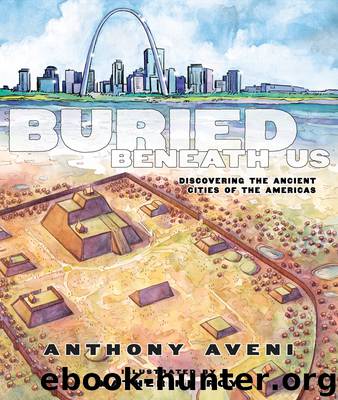Buried Beneath Us by Anthony Aveni

Author:Anthony Aveni
Language: eng
Format: epub
Publisher: Roaring Brook Press
An Aztec artist makes a small carving of Huitzilopochtli, the patron god of Tenochtítlan.
Attached to the religious rituals was a common set of beliefs grounded in myths or stories of creation that told where a city’s ancestors came from and why they were special. These stories and the symbols attached to them formed the basis of a city’s beliefs and traditions. Creation stories helped give citizens a shared identity. Some elements of these stories were true, and others were exaggerated just to make a good story. Creation stories are as important to modern American culture as they were to the first Americans. The tradition of twenty-first-century America is founded in the idea of democracy—we tell stories of our founding fathers, men who rebelled against an unjust king and wrote the Declaration of Independence and later the U.S. Constitution, to guarantee our freedom. A perfect example of a creation story that has been exaggerated to teach lessons about our founding principles is the story of George Washington chopping down the cherry tree. Many cultures identify their origins with sacred places that have existed since ancient times—cities like Mecca or Jerusalem. These ancient places help establish a city’s tradition by giving depth to its history and a secure sense that their beliefs have endured for many ages. These stories are designed to make people feel special and, above all, to unite them.
The Aztec story of creation became a part of the tradition of Tenochtítlan because it explained why warfare and sacrifice were necessary. The purpose of the story was to justify acquiring sacrificial victims to offer in payment to the sun god so that the people could help to keep the world in balance. The Aztec’s sacred place, where they say the story occurred, was an ancient city located twenty-five miles northeast of Tenochtítlan that had been abandoned long before the Aztecs arrived in the Valley of Mexico. Its giant pyramids were arranged along a ceremonial way they called the Avenue of the Dead. They named the ruined city Teotihuácan. It means “City of the Gods” or the “Place Where One Becomes Deified” in Nahuatl, the Aztec language. Using radiocarbon dating, archaeologists discovered that a thousand years before the Aztecs built their Great Temple of Tenochtítlan, the people of Teotihuácan had constructed their gigantic Pyramid of the Sun. It measures 740 feet, or more than two soccer fields across at its base, and is about 240 feet high. (That’s nearly half the height of the Washington Monument.) The Aztecs believed that the ancient ones who lived there were their gods. One of them told the Spanish conquerors: “It is said that when all was in darkness, when yet no sun had shone and no dawn had broken—it is said—the gods gathered themselves there at Teotihuácan. There they created the fifth sun.”
Here’s the story: All the gods had gathered at Teotihuácan after the world had been plunged into darkness at the end of the previous creation. But before they could create humans, one of them needed to sacrifice himself by walking into the cosmic fire.
Download
This site does not store any files on its server. We only index and link to content provided by other sites. Please contact the content providers to delete copyright contents if any and email us, we'll remove relevant links or contents immediately.
This Is How You Lose Her by Junot Diaz(6440)
The Kite Runner by Khaled Hosseini(4952)
The Mayflower and the Pilgrims' New World by Nathaniel Philbrick(4281)
Bloody Times by James L. Swanson(4242)
Pocahontas by Joseph Bruchac(4028)
Flesh and Blood So Cheap by Albert Marrin(3670)
An American Plague by Jim Murphy(3631)
The 101 Dalmatians by Dodie Smith(3300)
Hello, America by Livia Bitton-Jackson(3013)
Finding Gobi by Dion Leonard(2634)
Harry Potter and the Half-Blood Prince (hp-6) by J. K. Rowling(2369)
The Impossible Rescue by Martin W. Sandler(2212)
See You in the Cosmos by Jack Cheng(2078)
I Will Always Write Back by Martin Ganda(2037)
Bloody Times: The Funeral of Abraham Lincoln and the Manhunt for Jefferson Davis by James L. Swanson(1983)
When Dimple Met Rishi by Sandhya Menon(1934)
The Queen of Attolia by Megan Whalen Turner(1922)
The Crossover by Kwame Alexander(1850)
Hoodoo by Ronald L. Smith(1795)
